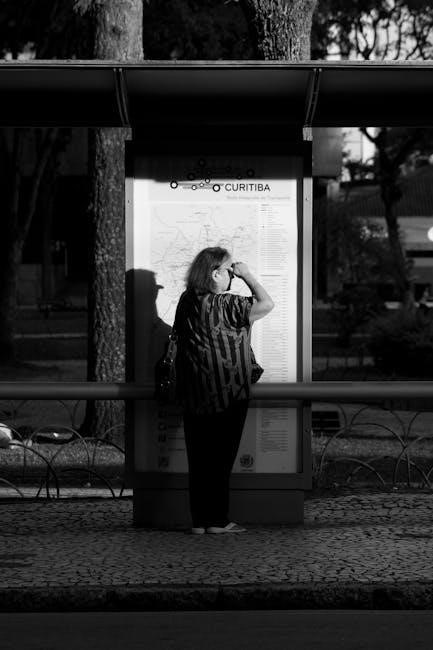This guide provides an in-depth exploration of Erik Larson’s The Devil in the White City, offering insights into its themes, characters, and historical context.
It helps readers understand the dual narrative of the 1893 Chicago World’s Fair and the sinister actions of H.H. Holmes, enhancing appreciation for this factual account.
1.1 Overview of the Book and Its Significance
The Devil in the White City by Erik Larson is a gripping historical account of the 1893 Chicago World’s Fair and the sinister crimes of H.H. Holmes. This nonfiction masterpiece weaves together the stories of innovation and evil, exploring themes of ambition, morality, and progress. Its unique narrative style blends meticulous research with engaging storytelling, making it a significant work in literary nonfiction. The book’s dual focus on the fair’s grandeur and Holmes’ darkness captivates readers, offering insights into human duality and societal transformation.
1.2 Purpose of the Reading Guide

This reading guide aims to enhance understanding of The Devil in the White City by providing detailed summaries, analyses, and insights into its themes, characters, and historical context. It serves as a comprehensive resource for students and readers, offering a deeper exploration of Erik Larson’s work. The guide helps unpack the book’s complex narratives, fostering critical thinking and appreciation for its literary and historical significance. It is designed to enrich the reading experience and facilitate meaningful discussions.
The Devil in the White City by Erik Larson intertwines the 1893 Chicago World’s Fair with the sinister crimes of H.H. Holmes, exploring ambition, innovation, and darkness.
2.1 Key Plot Points
The narrative centers on the 1893 Chicago World’s Fair, showcasing innovation and culture, while paralleling the sinister exploits of H.H. Holmes, a serial killer who preyed on visitors.
Daniel Burnham’s architectural brilliance contrasts with Holmes’ manipulation, as the fair’s success unfolds alongside his crimes, culminating in a gripping tale of ambition, deception, and justice.
2.2 Main Characters and Their Roles
H.H. Holmes, a charming serial killer, uses the 1893 Chicago World’s Fair to lure victims into his “murder castle,” showcasing his manipulative and sinister nature.
Daniel Burnham, the visionary architect, leads the fair’s construction, embodying ambition and creativity, while Holmes represents darkness and deception, creating a stark contrast between progress and evil.
2.3 Historical Context of the 1893 Chicago World’s Fair
The 1893 Chicago World’s Fair, also known as the Columbian Exposition, was a groundbreaking event showcasing American innovation, culture, and progress during the Gilded Age.
It highlighted the nation’s recovery from the Civil War and its rise as a global power, while also reflecting underlying social tensions and economic challenges of the late 19th century.
Themes in “The Devil in the White City”
The book explores themes of duality, ambition, and the darker side of progress, contrasting the brilliance of the World’s Fair with the evil of H.H. Holmes.
3.1 The Dual Nature of Human Beings
The book highlights the contrasting duality of human nature, exemplified by the brilliance of Daniel Burnham and the depravity of H.H. Holmes. While Burnham embodies creativity and ambition, Holmes represents manipulation and evil. This duality underscores the coexistence of good and evil, revealing how individuals can simultaneously create and destroy. The 1893 World’s Fair symbolizes hope and progress, while Holmes’ crimes expose the darkness lurking beneath human achievement, emphasizing moral ambiguity and the struggle between light and darkness.
3.2 Ambition and Its Consequences
Ambition is a central theme, as seen in the contrasting lives of Daniel Burnham and H.H. Holmes. Burnham’s relentless drive to create the 1893 World’s Fair symbolizes the positive power of ambition, showcasing human potential for innovation and progress. Conversely, Holmes’ ambition for control and destruction highlights its darker side, leading to devastating consequences. The book illustrates how ambition, while driving achievement, can also fuel obsession and harm when unchecked, reflecting the duality of human endeavor and the fine line between success and ruin.
3.3 Justice and Morality in Society
The book explores the tension between societal progress and moral decay, highlighting the contrast between the ideals of the 1893 World’s Fair and the sinister actions of H.H. Holmes. It examines how justice was served in the face of his crimes, while also revealing the darker aspects of human nature. The narrative underscores the struggle between morality and immorality, questioning the effectiveness of societal structures in upholding justice and protecting the innocent from evil.
3.4 The Impact of Progress and Innovation
The 1893 Chicago World’s Fair symbolized the pinnacle of human progress, showcasing groundbreaking architecture and technology. However, the book reveals how innovation coexisted with darkness, as H.H. Holmes exploited these advancements to commit his crimes. The fair’s transformative impact on society is contrasted with the sinister uses of progress, highlighting the duality of human ingenuity and its potential for both good and evil, reflecting the broader societal changes of the era.

Symbols and Motifs in the Book
The book explores symbols like the color white, representing purity but also deception, and fire, signifying destruction and transformation, highlighting the duality of human nature and progress.
4.1 The Symbolism of the Color White
The color white in The Devil in the White City symbolizes purity and progress, reflecting the 1893 World’s Fair’s image as a beacon of innovation and hope. However, it also represents deception, as the fair’s pristine appearance contrasts with the darker realities of H.H. Holmes’ crimes and the societal ills of the time. This duality underscores the book’s exploration of illusion versus reality and the moral ambiguities of human achievement.
4.2 The World’s Fair as a Symbol of Hope and Deception
The 1893 Chicago World’s Fair symbolizes hope through its dazzling display of innovation and progress, embodying the optimism of the American spirit. Yet, it also represents deception, as the fair’s grandeur and beauty mask the darker truths of H.H. Holmes’ crimes and the societal inequalities of the era. This duality highlights the tension between illusion and reality, central to the book’s narrative.
4.3 Fire as a Recurring Motif
Fire emerges as a powerful and recurring motif in The Devil in the White City, symbolizing both destruction and transformation. The Great Chicago Fire and the eventual burning of the fairgrounds underscore the fragility of human achievements. Fire also represents chaos and purification, mirroring the dual nature of progress and evil that permeates the narrative. Its presence serves as a reminder of the unpredictable forces that shape history and human destiny.
4.4 Water and Its Significance
Water in The Devil in the White City symbolizes purity and transformation, contrasting with the darkness of H.H. Holmes’ crimes. The 1893 World’s Fair, with its emphasis on progress, uses water features to showcase innovation. However, water’s cleansing power is limited, reflecting the inability to wash away the evil that lurked beneath the city’s grandeur. This duality underscores the book’s exploration of human nature’s light and dark aspects.

Historical Context and Background
The late 19th century set the stage for the 1893 Chicago World’s Fair, a time of innovation and societal change, while H.H. Holmes emerged as a criminal figure.
5.1 The 1893 Chicago World’s Fair
The 1893 Chicago World’s Fair, also known as the World’s Columbian Exposition, was a groundbreaking event showcasing innovation, culture, and progress. It highlighted Chicago’s rise as a major city and featured iconic architecture, including the “White City” designed by Daniel Burnham. The fair symbolized hope and unity, attracting millions and leaving a lasting legacy in American history and culture.
5.2 The Rise of H.H. Holmes and His Crimes
H.H. Holmes, born Herman Webster Mudgett, was a notorious serial killer who exploited the 1893 Chicago World’s Fair. He lured victims into his “murder castle,” a hotel with secret rooms and traps. His crimes went undetected for months, shocking the nation upon discovery. Holmes’s reign of terror during the fair’s peak symbolized the darker side of human nature, contrasting sharply with the event’s ideals of progress and innovation.
5.3 The Architectural and Cultural Significance of the Era
The 1893 Chicago World’s Fair showcased groundbreaking architecture, led by Daniel Burnham, with its iconic “White City” design. The event highlighted the era’s cultural shift toward innovation and progress, blending art and technology. It inspired future architectural movements and symbolized America’s rise as a global power, leaving a lasting legacy in design and cultural influence during a transformative period in history.

Key Figures in the Book
Erik Larson’s The Devil in the White City centers on two pivotal figures: H.H. Holmes, the notorious serial killer, and Daniel Burnham, the visionary architect behind the 1893 Chicago World’s Fair. Their contrasting roles symbolize the duality of human nature, with Holmes embodying evil and Burnham representing innovation and progress, both leaving lasting impacts on history and culture.
6.1 H.H. Holmes: The Serial Killer
H.H. Holmes, born Herman Webster Mudgett, was a notorious serial killer who exploited the 1893 Chicago World’s Fair to lure victims into his “murder castle.” His hotel, designed with secret passages, hidden rooms, and soundproofed chambers, became a trap for unsuspecting visitors. Holmes confessed to 27 murders, though the actual number may be higher. His crimes shocked the nation, blending deception and brutality, making him one of America’s first modern serial killers.
6.2 Daniel Burnham: The Architect of the World’s Fair
Daniel Burnham was a visionary architect who played a pivotal role in designing the 1893 Chicago World’s Fair. His leadership and innovative designs transformed the event into a landmark of architectural excellence. Burnham’s ability to manage a vast team and meet tight deadlines showcased his exceptional organizational skills. His work not only highlighted the potential of urban planning but also left a lasting legacy in American architecture and cultural history.
The Architectural Marvel of the 1893 World’s Fair
The 1893 Chicago World’s Fair showcased groundbreaking architecture, blending innovation and grandeur. Its design, led by Daniel Burnham, featured iconic structures that captivated visitors worldwide.
7.1 The Design and Construction of the Fairgrounds
The 1893 Chicago World’s Fair, led by architect Daniel Burnham, featured a visionary design blending neoclassical styles with innovative construction techniques. The fairgrounds, known as the “White City,” included grand structures like the Administration Building and the Great Basin. Despite tight deadlines and challenges, the team created a temporary yet awe-inspiring city, showcasing American ingenuity and setting new standards for urban planning and architecture.
7.2 The Legacy of the Fair’s Architecture
The 1893 World’s Fair left a lasting impact on architecture, inspiring the “City Beautiful” movement and influencing urban design. Its neoclassical style and innovative use of materials set new standards, while the fair’s temporary nature showcased the potential of grand, yet ephemeral, structures. The fairgrounds’ design continues to be studied, highlighting the interplay between aesthetics and functionality that defined the era’s architectural advancements.
Erik Larson’s Writing Style and Approach
Larson masterfully blends meticulous historical research with compelling narrative techniques, creating a gripping account that reads like fiction while remaining rooted in factual accuracy and detail.
8.1 Blending History and Narrative
Erik Larson seamlessly merges historical facts with engaging storytelling, creating a captivating narrative that explores the 1893 Chicago World’s Fair and the sinister actions of H.H. Holmes.
His approach transforms dry historical data into a compelling tale, blending the achievements of Daniel Burnham with the horrors of Holmes’ crimes, making history accessible and immersive for readers.

8.2 The Use of Literary Devices
Erik Larson employs literary devices like juxtaposition, vivid descriptions, and suspense to enhance the narrative, blending historical facts with engaging storytelling.
His use of imagery and symbolic elements, such as the contrast between light and darkness, underscores the dual nature of human beings, a central theme of the book.
These techniques create a captivating atmosphere, drawing readers into the world of the 1893 Chicago World’s Fair and the shadow of H.H. Holmes’ crimes.

The Meaning and Significance of the Title
The title reflects the duality of human nature, symbolizing evil amidst progress, as embodied by H.H. Holmes and the 1893 Chicago World’s Fair’s idealism.
9.1 The “Devil” in the Context of the Book
The term “Devil” symbolizes H.H. Holmes, a serial killer who exploited the 1893 Chicago World’s Fair. His sinister actions contrast with the fair’s ideals, embodying evil amidst progress. The title highlights the duality of human nature, where darkness coexists with innovation and hope. Holmes’s crimes, hidden behind a charming facade, illustrate the devilish manipulation and horror that unfolded in the shadow of the “White City.”

9.2 The “White City” and Its Symbolism
The “White City” represents the 1893 Chicago World’s Fair, a beacon of innovation and progress. Its pristine architecture and illuminated grounds symbolized hope and unity, contrasting with the darkness of H.H. Holmes’s crimes. The term embodies the fair’s ideals of cultural and technological advancement, while also hinting at the illusion of perfection that concealed underlying societal flaws and moral ambiguities of the time.
The Impact and Legacy of the Book
The Devil in the White City became a bestseller, earning critical acclaim and awards. Its unique blend of history and narrative influenced popular culture and inspired adaptations, solidifying its place as a landmark work in literary nonfiction.
10.1 Critical Reception and Awards
The Devil in the White City received widespread critical acclaim for its meticulous research and engaging narrative. It won the Edgar Award for Best Fact Crime in 2004 and became a New York Times bestseller. Reviewers praised Larson’s ability to weave history and suspense, making the book a landmark in literary nonfiction. Its success has endured, solidifying its reputation as a masterful blend of history, crime, and storytelling.
10.2 Popular and Cultural Influence

The Devil in the White City has left a lasting impact on popular culture, inspiring film and TV adaptations. Its chilling narrative has captivated audiences, fostering a renewed interest in the 1893 World’s Fair and H.H. Holmes. The book’s themes of ambition and morality resonate widely, making it a cultural touchstone. Its influence extends to the true crime genre, with many crediting it as a pioneer in blending history and suspense for modern audiences.

Discussion Questions for Readers
How do the themes of ambition and morality shape the characters’ actions? What lessons can modern readers draw from the book’s historical context? How does the intersection of fact and narrative enhance the storytelling? These questions encourage deeper reflection on the book’s complexities and relevance today.
11.1 Themes and Their Relevance Today
The book explores themes like ambition, morality, and the dual nature of humanity, which remain highly relevant. The contrast between progress and evil, as seen in the 1893 World’s Fair and H.H. Holmes’s crimes, prompts readers to reflect on how societal ambitions can coexist with darkness. These themes encourage discussions on justice, ethics, and the enduring struggle between good and evil in modern society.
11.2 Character Analysis and Motivations
H.H. Holmes’s psychopathic tendencies and calculating nature drove his manipulative actions, while Daniel Burnham’s perfectionism and vision for the future fueled his architectural achievements. Their diverging paths highlight the contrast between evil and ambition. Holmes’s desire for control and Burnham’s pursuit of legacy reveal the complexities of human motivation, inviting readers to explore the psychological and emotional forces that shape individuals and their choices.
11.3 The Intersection of History and Fiction
Erik Larson masterfully blends historical facts with narrative techniques, creating a compelling account of the 1893 Chicago World’s Fair and H.H. Holmes’s crimes. This approach transforms history into a gripping story, making it accessible and engaging for readers. The book’s factual accuracy, combined with its storytelling style, highlights the power of historical narrative to captivate and inform, offering a unique perspective on real events.
The Devil in the White City offers a captivating blend of history and suspense, leaving readers with a profound understanding of human duality and historical significance, ensuring its lasting impact.
12.1 The Enduring Appeal of the Book
Erik Larson’s The Devil in the White City captivates readers with its unique blend of historical narrative and chilling storytelling, making it a timeless classic. The book’s ability to weave together the brilliance of the 1893 World’s Fair with the sinister exploits of H.H. Holmes creates a fascinating contrast that continues to intrigue audiences. Its exploration of human duality and societal progress ensures its relevance, solidifying its place as a compelling and thought-provoking read.
12.2 The Importance of Historical Awareness
Historical awareness is crucial for understanding the societal and cultural dynamics of the late 19th century, as depicted in The Devil in the White City. The book highlights the duality of progress and darkness, reminding readers of the lessons history offers. By examining the 1893 World’s Fair and H.H. Holmes’ crimes, the narrative underscores the importance of learning from the past to avoid repeating its mistakes and to appreciate the advancements that shape modern society.
